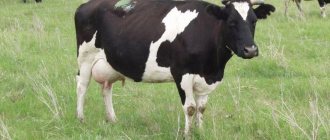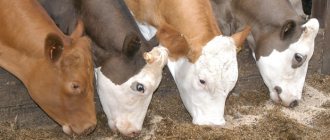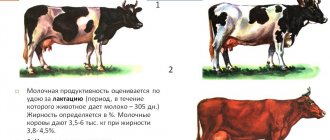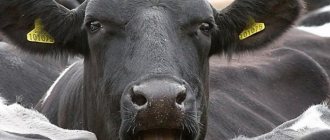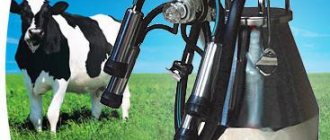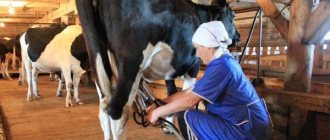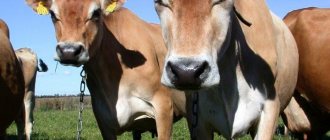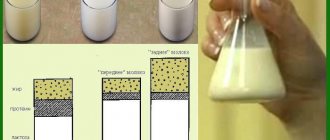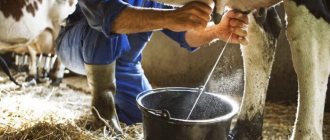Biology
Fasciola is shaped like a plant leaf, up to 3 cm long. For the parasite to fully develop, two hosts are needed - an intermediate and a definitive one. The main host is a ruminant, the preliminary host is a freshwater mollusk. The parasite egg leaves the body with excrement and ends up in standing water. After one or two decades, the miracidium hatches, which, floating freely, penetrates the body of the victim, where it reproduces by division, going through several phases of development. The last of them - the cercarium leaves the intermediate host, encysts, turning into an adolescaria. The parasite sticks to a blade of grass, waiting for the herbivore to swallow it. Cattle can become infected with fascioliasis by drinking from a puddle infested with Adolescaria. When kept in stalls, invasion is possible if you feed green mass mown in wet meadows. A person can become infected with fascioliasis through contact with water from dirty puddles.
The aquatic phase of parasite development takes 2–2.5 months. Fascioliasis infection occurs on wet pastures in late summer or early autumn. Cercariae are able to overwinter in the body of a mollusk, which can withstand freezing.
Scheme
In the intestine, the parasite larva emerges from the cyst, migrates to the liver and colonizes the bile ducts. After 105–140 days, Fasciola becomes sexually mature. It feeds on blood components from nearby capillaries. Fasciola is a bisexual parasite, capable of self-fertilization or by mating with another individual. The helminth lives for 5 years. Infection with fascioliasis occurs at the end of summer, and clinical signs appear when the parasites reach maturity, that is, in the spring.
Intermediate hosts of Fasciola
Prevention methods
Prevention of fascioliasis in cattle involves the use of the above drugs, primarily hexachloroparaxylene, in winter and spring to prevent an outbreak of the disease.
In general, routine preventive deworming is one of the most reliable ways to prevent mass infection.
If the epidemic does break out, it is recommended to transfer the cattle to stall housing.
To prevent invasion, it is necessary to take a number of measures aimed at destroying the carriers of the disease - mollusks:
- drain swampy areas in pastures and build drainage systems;
- prevent cattle from accessing irrigated lands using an “electric shepherd” - a wire fence through which an electric current is passed;
- treat mollusk habitats with molluscicidal solutions;
- for watering, use not irrigation canals, but imported water that has passed sanitary and epidemiological control;
- periodically change the area for pasture;
- for preventive purposes, deworm cattle at least twice a year (before transferring cattle to stall housing and then again after 2.5-3 months).
Pathogenesis
The development of painful symptoms begins at the stage of migration of fasciola larvae. They injure tissues, especially the liver. Parasites grow quickly and clog the bile ducts, even to the point of their destruction. Metabolites of trematodes are toxic and allergens. Pathological processes in fascioliasis begin in the liver, gradually spreading to the entire body. The activity of the parasite leads to the following disorders in the body:
- The number of red blood cells in the blood decreases, the concentration of hemoglobin, the level of calcium and phosphorus drops.
- Increased breakdown of red blood cells is confirmed by an increase in bilirubin levels. Eosinophilia indicates the presence of parasitic infestation.
- Hypovitaminosis A and B12 develops. Fasciola deplete retinol and cyanocobalamin reserves
- Migrating parasites infect pathways with pathogenic bacteria. Necrotizing hepatitis is considered the most dangerous infectious concomitant disease.
Symptoms
At the initial stage, fascioliasis in cattle occurs with mild symptoms. Since the development cycle of the parasite is long, there are no clinical manifestations in calves. As the fascioli grow, the following signs of the disease gradually appear:
- With balanced feeding, a decrease in the animal’s fatness is observed.
- Appetite is distorted, licking occurs, caused by an increased need for minerals and vitamins.
- Periodically, swelling of the scar occurs.
- Atony occurs.
- The coat loses its shine and looks disheveled.
- The mucous membranes become pale, then icteric.
- Milk productivity is falling.
- Pregnant cows abort.
- Symptoms of severe anemia develop.
Unsatisfactory feeding aggravates the course of fascioliasis. The death of the animal, with an increase in pathological symptoms, occurs from cachexia.
Cachexia
Fascioliasis: causes and symptoms
Fascioliasis manifests itself differently in animals. In cattle, it can also have different manifestations, it all depends on fatness, living conditions, age, intensity of invasion, as well as on individual characteristics. Cows are most likely to show signs of fascioliasis, or perhaps a drop in milk production is more noticeable and the owner begins to look for reasons.
A clinical examination of a cow may not lead to a diagnosis, and only laboratory diagnostics will reveal fascioliasis.
However, fasciola does not release eggs into the external environment all year round. Therefore, material for research can be selected only in the 1st and 4th quarters of the year, that is, in winter.
This feature of the parasite causes confusion when making a diagnosis. The cow is sick, but it is not possible to make an accurate diagnosis.
That is why it is necessary to conduct scatological examinations of the animal’s feces every year after placing it in a stall.
Young cattle are more sensitive to fascioliasis than adults. Although its manifestation can also occur in a latent form, eggs are detected in the laboratory more often.
Small cattle, sheep, and goats suffer from fascioliasis in a more acute form than cattle. In infected sheep, the mucous membranes turn pale, then yellowness appears.
Sometimes tympania (swelling of the scar), bloody diarrhea, and constipation are observed. Appetite decreases or is absent altogether.
In young small cattle, cardiac activity is disrupted, arrhythmia and tachycardia are heard. When transitioning to a chronic course, after a few months the animals lose weight, trail at the end of the herd, the wool becomes brittle and easily falls out.
If the infestation of a livestock flock is small, clinical signs may not be observed.
Diagnostics
Fascioliasis in cows is diagnosed by analyzing the following data:
- Epizootic situation. The seasonality of exacerbation of diseases, as well as the presence of swampy or damp pastures, are taken into account.
- Clinical symptoms.
- Detection of fasciola eggs in feces.
- Pathological changes. Parasites are found in the corpse or carcass of a forced slaughtered animal.
- Blood tests reveal the development of anemia, as well as the presence of helminths.
- The presence of pseudopositive reactions to the administration of tuberculin allows one to suspect fascioliasis.
Fascioliasis pathogen eggs
Treatment
When fascioliasis occurs in cows, they are treated with specific drugs. Most of them are toxic to humans, so restrictions are placed on the use of meat and milk for food purposes. A number of anthelmintics are prohibited for use on lactating cows. Therefore, within the framework of this publication, only medications will be considered, after the use of which both types of livestock products can be consumed.
With fascioliasis, the fur is ruffled
For cattle fascioliasis, the following drugs are in demand:
- hexachloroparaxylene;
- hexachloroethane;
- let's close;
- acemidophen;
- chaskoverm;
- hexychol.
Hexachloroparaxylene
They produce powder for oral use. Used for fascioliasis once in a group method, adding to crushed grain. During deworming, it is necessary to remove easily fermentable foods from the diet (2 days before and after use). For poisoning, baking soda is used as an antidote. The instructions do not indicate restrictions on meat and milk after using the drug.
Hexachloroethane
Powder. Added to feed for fascioliasis in the form of a suspension with bentonite clay, which promotes the digestibility of the active component. Apply twice with an interval of 3 days. When deworming, easily fermentable components of the diet are removed in the same way as when using Hexachloroparaxylene, but for 4 days. Side effects are tympany or atony, the antidote is creolin or lactic acid.
Clozatrem
Sterile solution for intramuscular use in fascioliasis. The deadline for milk and meat is 4 weeks.
Acemidophen
Aqueous suspension, mixed with food. Used once for fascioliasis, normalized according to the active substance. The waiting period for milk and meat is two weeks.
Fascoverm
Injectable drug. Used for fascioliasis once, 5 ml/100 kg of weight. Waiting time - 2 weeks.
Hexyhol
Oral remedy. For fascioliasis, it is given with food at 30 g/100 kg of weight. Before consumption, easily fermentable components are removed from the diet - one day before and after. Together with the anthelmintic, table salt is given at 60 g/100 kg weight.
Treatment of helminthic pathology
Treatment of animals is carried out using deworming drugs. The following medications have proven themselves to be positive: Disalan, Sulfen, Acemidophen, Hexachloroparaxylene, Closantel.
"Disalan" should be added to cows' feed. 0.01g/kg is enough. “Sulfene” is combined with feed in an amount of 0.1 g/kg. You can also use 1% flour slurry.
"Acemidophen" is mixed with feed at a dosage of 0.15 g/kg. Hexachloroparaxylene is also added to the feed. You need to mix 0.5 g of the product with 1 kg of chopped grain (based on 1 kg of weight). Closantel is administered intramuscularly or subcutaneously. Requires 1 ml per 10 kg of weight or 1 ml per 20 kg, respectively.
Therapy is prescribed on an individual basis. Veterinarians take into account the age of the cow, the degree of infection, and the results of laboratory tests. You cannot self-medicate, otherwise it may result in the death of the animal.
Control measures
To successfully combat the parasite, you need to know its biology and break the cycle of fasciola development. The main thing is to change the habitat of the preliminary host. To this end, the following measures are being taken:
- stall housing;
- land reclamation;
- cultivated pastures;
- replacement of grazing areas;
- disinfestation of barns;
- biothermal disposal of manure;
- deworming of cows, three times per season;
- destruction of shellfish.
Stall housing
Year-round loose housing protects animals from the parasite. To provide cows with grass, a green conveyor is organized, mainly from sown crops. It is known that the yield of forage plants is many times higher than the collection of green mass or hay from natural lands. If it is customary to use grass from meadows, avoid mowing it in wetlands. In addition to the fact that there is a risk of infection with fascioliasis, the green mass grown on waterlogged soil is represented by sedge plants and has low nutritional value. To prevent invasion, you need to wait until the parasite larvae are inactivated. Therefore, hay harvested in swamps is used after six months of aging.
Year-round housing protects against fascioliasis
Land reclamation
Drainage systems are constructed and swampy areas of pastures, which are reservoirs for parasites, are drained.
Arrangement of cultivated pastures
Accelerated tinning technology is effective. The soil is plowed, fertilized, drained, sown with grass-legume mixtures, and an electric shepherd is used. To prevent livestock from ingesting the parasite, natural reservoirs are isolated and watered with imported water.
Cultural pasture with electric shepherd
Change of pastures
The life cycle of Fasciola from egg to adolescaria is 70–100 days, so to interrupt the development of the parasite it is necessary to change pastures after two months of use.
Manure neutralization
The removal of unrotted feces to the field contributes to the spread of parasite eggs. Therefore, defects are stored. When overheated, the temperature rises and the parasites die. Humus can be taken to the field.
Rotted manure
Deworming
Problematic farms deworm all ruminants, including small ones. When kept on pasture, treatment against fascioliasis is carried out three times a year. If a parasite is detected in the summer, cows are dewormed in areas subject to plowing. Fields where crops have been harvested are used as pasture. The cattle are dewormed and kept for 6 days to free the alimentary tract from parasites.
Destruction of shellfish
There are two methods of destroying shellfish:
- Chemical. Spray problem areas with copper sulfate.
- Biological. They breed waterfowl that eat shellfish.
Prevention and control measures
Based on the developmental characteristics of the parasite. It is important to interrupt the cycle of transformation of fasciolae and prevent infection of animals. For this purpose, it is recommended to eliminate the possibility of infection of intermediate hosts:
- land reclamation - arrangement of drainage channels, soil drainage;
- use of anti-mollusc drugs (copper sulfate, slaked lime);
- grazing cows on cultivated pastures;
- changing grazing areas every two months;
- deworming of cows three times during the grazing period.
The rarest cases of the disease are detected during year-round housing with the use of a walking area. During the summer season, cows receive green material only from cultivated meadows free from wetlands.
To prevent eggs from entering the external environment, preventive disinfection of barns should be carried out. Manure is subjected to biothermal disinfection. It is prohibited to transport fresh manure to fields, as fodder plants become infected.
It is necessary to carry out laboratory diagnostics of stool on the farm. It is carried out twice a year - during the transition to summer housing and before placing in winter stalls. Samples are taken from a tenth of the entire herd, and if parasite eggs are detected, forced deworming and disinfection of the premises are carried out.
